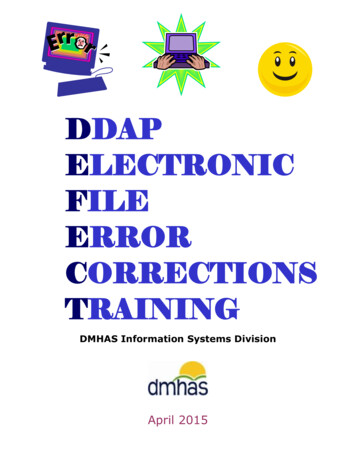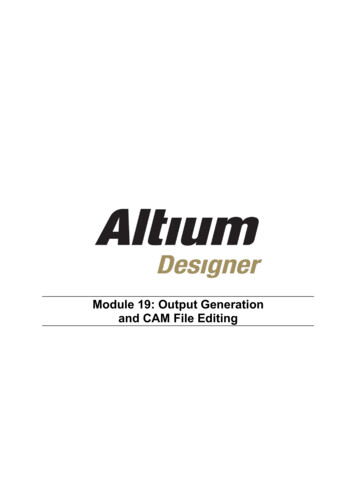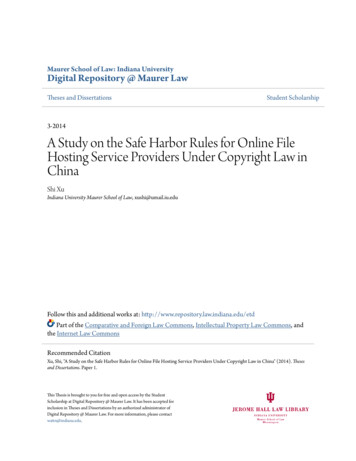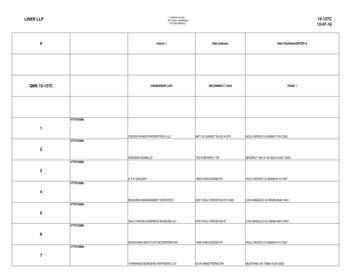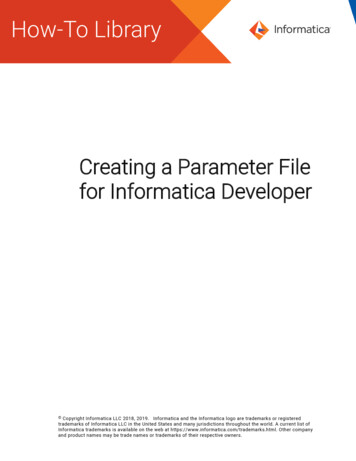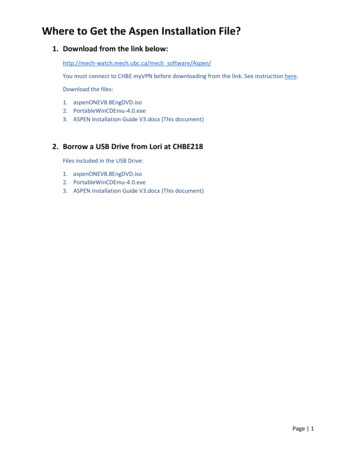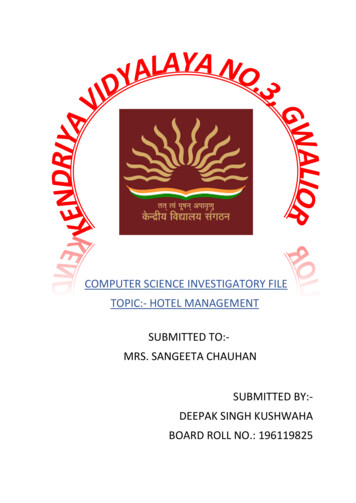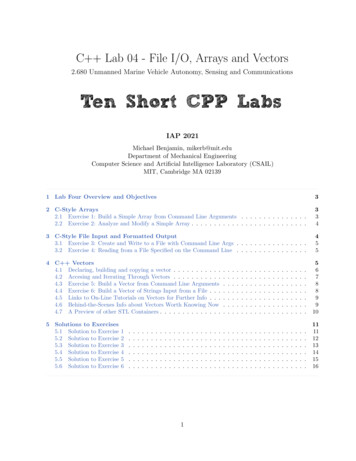
Transcription
C Lab 04 - File I/O, Arrays and Vectors2.680 Unmanned Marine Vehicle Autonomy, Sensing and CommunicationsIAP 2021Michael Benjamin, mikerb@mit.eduDepartment of Mechanical EngineeringComputer Science and Artificial Intelligence Laboratory (CSAIL)MIT, Cambridge MA 021391 Lab Four Overview and Objectives32 C-Style Arrays2.1 Exercise 1: Build a Simple Array from Command Line Arguments . . . . . . . . . . . . . . .2.2 Exercise 2: Analyze and Modify a Simple Array . . . . . . . . . . . . . . . . . . . . . . . . . .3343 C-Style File Input and Formatted Output3.1 Exercise 3: Create and Write to a File with Command Line Args . . . . . . . . . . . . . . . .3.2 Exercise 4: Reading from a File Specified on the Command Line . . . . . . . . . . . . . . . .4554 C Vectors4.1 Declaring, building and copying a vector . . . . . . . . . . .4.2 Accesing and Iterating Through Vectors . . . . . . . . . . .4.3 Exercise 5: Build a Vector from Command Line Arguments4.4 Exercise 6: Build a Vector of Strings Input from a File . . .4.5 Links to On-Line Tutorials on Vectors for Further Info . . .4.6 Behind-the-Scenes Info about Vectors Worth Knowing Now4.7 A Preview of other STL Containers . . . . . . . . . . . . . .5678899105 Solutions to Exercises5.1 Solution to Exercise5.2 Solution to Exercise5.3 Solution to Exercise5.4 Solution to Exercise5.5 Solution to Exercise5.6 Solution to Exercise.11111213141516123456.1.
2
1Lab Four Overview and ObjectivesThis lab covers two topics that tie together to produce a nice utility function we will use in laterlabs. We cover C-style arrays and their more modern counterpart vectors commonly used C .Along the way we introduce file input/output (I/O) to give us the power of reading to and fromfiles. In the end we build a simple utility for reading the contents of a file into a vector of strings. C-Style Arrays C-Style File Input and Formatted Output C Vectors2C-Style ArraysThe C language provides a robust mechanism for representing and using arrays, which are contiguous blocks of memory holding elements of the same data type. This is a fundamental conceptunderpinning C and C and commonly found in most if not all programming languages. C now provides alternative data structures such as the vector which is simpler to use and less proneto programmer error. So an array in typical modern C code is more likely to be implementedusing a vector and for this reason we refer to simple memory arrays as ”C-style” arrays.Since C-style arrays are still commonly found in legacy and even newer C code, we take a lookat these before introducing and advocating the use of the vector later in the lab. We will do a shortexercise with C-style arrays, but first, read the page(s) below on C-style arrays. http://www.cplusplus.com/doc/tutorial/arrays http://www.tutorialspoint.com/cplusplus/cpp arrays.htm2.1Exercise 1: Build a Simple Array from Command Line ArgumentsWrite a program to read in any number of integers from the command line, constructing an arrayof such integers, and printing them out afterwards. Your array should be exactly the size of thenumber of integers read in from the command line. You can assume all arguments on the commandline are valid integers.Call your file arrays.cpp and build it to the executable arrays. When your program runs, itshould be invocable from the command line with: ./arrays 1 2 3 88 43 26Total amount of integers provided: 6numbers[0]: 1numbers[1]: 2numbers[2]: 3numbers[3]: 88numbers[4]: 43numbers[5]: 26The solution to this exercise is in Section 5.1.3
2.2Exercise 2: Analyze and Modify a Simple ArrayContinuing with the first exercise, write a program to read in any number of integers from thecommand line, constructing an array of such integers, and printing them out afterwards. Your arrayshould be exactly the size of the number of integers read in from the command line. Following thisscan the array and determine the smallest number and build a new array of size N-1 removing atmost one element of the first array equal to the smallest element. You can assume all arguments onthe command line are valid integers.Call your file array nosmall.cpp and build it to the executable array nosmall. When yourprogram runs, it should be invocable from the command line with: ./arrays nosmall 1 88 43 1 7 26Total amount of integers provided: 6numbers[0]: 1numbers[1]: 88numbers[2]: 43numbers[3]: 1numbers[4]: 7numbers[5]: 26The new array of integers:numbers[0]: 88numbers[1]: 43numbers[2]: 1numbers[3]: 7numbers[4]: 26The solution to this exercise is in Section 5.2.3C-Style File Input and Formatted OutputThe next topic is file I/O, reading from and writing to a file on your computer from within a C orC program. Pretty much everything you need for reading and writing can be found in the belowfive functions, which squarely fall in the realm of C but supported of course in C . There areseveral other options and functions to do similar things, but the below is pretty complete. Take alook at them and follow the examples. Pay special attention to the options for the fopen() function.Following this are a couple simple exercises. fopen()http://www.tutorialspoint.com/c standard library/c function fopen.htm fclose()http://www.tutorialspoint.com/c standard library/c function fclose.htm fprintf()http://www.tutorialspoint.com/c standard library/c function fprintf.htm feof()http://www.tutorialspoint.com/c standard library/c function feof.htm fgetc()http://www.tutorialspoint.com/c standard library/c function fgetc.htm4
3.1Exercise 3: Create and Write to a File with Command Line ArgsWrite a program that accepts a number of strings on the command line and creates a new file, alsospecified as a command line argument. The new file will contain one line for each provided commandline argument (except for the argument specifying the file name). For this exercise, you will need toknow about the fopen(), fclose(), and fprintf functions found on the above web pages, plus someof your knowledge obtained in prior lab exercises for handling command line arguments.Call your file fileout.cpp and build it to the executable fileout. When your program runs, itshould be invocable from the command line with: ./fileout --filename test.txt one two three four cat test.txtonetwothreefourThe solution to this exercise is in Section 5.3.3.2Exercise 4: Reading from a File Specified on the Command LineWrite a program that accepts a given filename on the command line, opens the file for reading, andreads in each line to a string. The string will have the format: line: [contents] where contents isthe raw contents of the line in the file including white space. Your program should then output eachstring to the terminal. For this exercise, you will need to know about the fopen(), fclose(), andfeof() and fgetc() functions found on the above web pages, plus some of your knowledge obtainedin prior lab exercises for handling command line arguments.Call your file filein.cpp and build it to the executable filein. When your program runs, it shouldbe invocable from the command line with: ./filein --filename test.txtline: [one]line: [two]line: [three]line: [four]The solution to this exercise is in Section 5.4.4C VectorsIn the situation where one would otherwise use an array in C, code writers in C are more likelyto use the vector class. Even though we haven’t covered C classes yet in this lab, this shouldn’tstop us from seeing how a vector can be used in basic operations similar to an array. We will pointyou to a couple on-line tutorials on the vector which treat the topic more thoroughly, but first adescription of the minimal things you should know:5
4.1Declaring, building and copying a vectorOne the best things about the vector is that, unlike a C-style array, you don’t need to specify thesize when it is declared.intmy array[100];vector int my vector;// Declaring an C-style array of integers// Declaring an array of integers using a vectorThe above my vector is initially empty and elements are added always to the end with:my vector.push back(22);my vector.push back(17);my vector.push back(43);Note that when the vector is initially declared, it is empty, so the following would not work:vector int my vector;my vector[0] 22;my vector[1] 17;my vector[2] 43;// error: accessing at an index out-of-bounds////If you would like to declare a vector with an initial size and default value for each element, this canbe done with:vector int my vector(100, 0);my vector[0] 22;my vector[1] 17;my vector[2] 43;// my vector has 100 elements all zero// Now this is ok. 22 overwrites zeroAs with most all C structures like the vector they can copied very simply as you would withfundamental data types like int or double:vector int my vector(100, 0);my vector[0] 22;my vector[1] 17;my vector[2] 43;// my vector has 100 elements all zero// Now this is ok. 22 overwrites zerovector int his vector my vector;// his vector has 100 elements {22,17,43,.,0}Since a vector size is not set in stone upon creation, elements may be removed too (from the end)with the pop back() function:vector int my vector;my vector.push back(22);my vector.push back(17);my vector.push back(43);.my vector.pop back();// my vector initially has no elements//// my vector now has three element// my vector now has two elements {22,17}6
4.2Accesing and Iterating Through VectorsAccessing and iterating through a vector is very similar to array, but since the vector size is notfixed at the outset, we often want to know the size of the vector to prevent accessing an index outof bounds.vector int my vector;my vector.push back(22);my vector.push back(17);my vector.push back(43);// my vector initially has no elements//// my vector now has three elementunsigned int total elements my vector.size();Note the type returned by the size() function is of type unsigned int since the size can never be lessthan zero. Accessing a vector is the same as an array, e.g., my vector[8] refers to the 9th element,and can be used on the left or right side of an assignment operator or passed as a parameter to afunction. In fact the whole vector can be passed as a parameter in a function. Iterating through anarray is also very similar:vector int my vector;my vector.push back(22);my vector.push back(17);my vector.push back(43);// my vector initially has no elementsint total 0;for(unsigned int i 0; i my vector.size(); i )total my vector[i];A vector may be ”reset” or emptied with the clear() function:vector int my vector;my vector.push back(22);my vector.push back(17);my vector.push back(43);// my vector initially has no elementsmy vector.clear();// my vector again has no elements// my vector has three elementsLastly, it is often useful to know the last element of a vector regardless of the index of the lastelement. For this, use the back() function:vector int my vector;my vector.push back(22);my vector.push back(17);my vector.push back(43);// my vector initially has no elements// my vector has three elementsint val my vector.back(); // val is set to 43, my vector still has three elements7
4.3Exercise 5: Build a Vector from Command Line ArgumentsWrite a program, similar to Excercise 2, to read in any number of integers from the command line,but constructing this time a vector of such integers, and printing them out afterwards. As before,scan the vector and determine the smallest number and build a new vector of size N-1 removing atmost one element of the first vector equal to the smallest element. You can assume all argumentson the command line are valid integers.Call your file vectors nosmall.cpp and build it to the executable vectors nosmall. When yourprogram runs, it should be invocable from the command line with similar output: ./vectors nosmall 1 88 43 1 7 26Total amount of integers provided: 6numbers[0]: 1numbers[1]: 88numbers[2]: 43numbers[3]: 1numbers[4]: 7numbers[5]: 26The new array of integers:numbers[0]: 88numbers[1]: 43numbers[2]: 1numbers[3]: 7numbers[4]: 26The solution to this exercise is in Section 5.5.4.4Exercise 6: Build a Vector of Strings Input from a FileCompletion of this exercise is the primary goal of this lab. This exercise asks you to build a utilityfunction we will use in later labs, that essentially reads the contents of a file into a vector of strings.We have touched on all the components of this through prior exercises so far, so this should justpull things together.Write a program that reads in one argument from the command line (--filename file), and readsin the contents of this file into a vector of strings. Afterwards, all non-empty strings will be writtento the terminal on a separate line. An empty line should be indicated as empty.Your program should consist of three files, filebuff main.cpp containing your main() function andFileBuffer.h and FileBuffer.cpp containing your utility function. When your program runs, itshould be invocable from the command line with:8
cat test.txtonetwothree// Assuming a test file with five lines, one of them blankfour ./filebuff --filename test.txtline: [one]line: [two]line: [three]line: Empty!line: [four]The solution to this exercise is in Section 5.6.4.5Links to On-Line Tutorials on Vectors for Further InfoHere are a few good links for further reading. Feel free to explore and try some of the things yousee. This link provides an example of a matrix with two rialC STL.html This link also touches on algorithms available for operation on vectors, such as sorting ctors.html Here you can see all the functions defined on a vector in the menu on the lefthand side of vector/vector/4.6Behind-the-Scenes Info about Vectors Worth Knowing NowSome of the web links above touch on these issues, but in case you didn’t read them or want furtheremphasis, we discuss a few of these ideas here.Memory allocation in vectors:The issue of allocating memory is largely hidden from the user when using a vector. A vector stilluses a contiguous block of memory just like an array, but the user typically isn’t concerned howthe vector obtains or grows this memory. A vector has a capacity which is always greater or equalto the number of elements in the array. The vector will grow the capacity as needed, behind thescenes without the user needing to be concerned with the when or how. A good discussion can befound here: vector capacity: apacity/At times the user may want to think about vector capacity. If you are building a big vector bypushing one element at a time onto the end, the vector capacity will up-size periodically along theway by grabbing a bigger chunk of memory and copying the existing contents into the new memorybefore proceeding. However, if you know this vector will contain say a million elements, you can set9
the capacity right at the time of creation so no re-sizing ever needs to be done. If this operation is acore operation (repeated many times over and over in a short period) in your program, then thereservation of vector capacity can make the difference in having a program that runs sufficientlyfast.A few things to remember about vector capacity: There is no way to set capacity at declaration. It is a two step process. First the declaration,then the reservation of capacity:vector int vector a;vector a.reserve(1000000);.vector int vector b(1000000);// Has size 0. Capacity exactly 1,000,000// Has size 1,000,000. Capacity 1,000,000 Invoking the clear() function doesn’t change it’s capacity, but sets the size to zero. You can know the capacity by invoking the capacity() function.4.7A Preview of other STL ContainersThe vector is but one type of container available in C . Below are a few short descriptions ofother useful containers we may explore in later labs. These are all from the cplusplus.com website. deque (usually pronounced like ”deck”) is an irregular acronym of double-ended queue. Doubleended queues are sequence containers with dynamic sizes that can be expanded or contractedon both ends (either its front or its back). Maps are associative containers that store elements formed by a combination of a key valueand a mapped value, following a specific order. In a map, the key values are generally used tosort and uniquely identify the elements, while the mapped values store the content associatedto this key. Sets are containers that store unique elements following a specific order. In a set, the valueof an element also identifies it (the value is itself the key), and each value must be unique.The value of the elements in a set cannot be modified once in the container, but they can beinserted or removed from the container. Lists are sequence containers that allow constant time insert and erase operations anywherewithin the sequence, and iteration in both directions. List containers are implemented asdoubly-linked lists; Doubly linked lists can store each of the elements they contain in differentand unrelated storage locations. The ordering is kept internally by the association to eachelement of a link to the element preceding it and a link to the element following it.10
5Solutions to Exercises5.1Solution to Exercise -----------------------*//* FILE: arrays.cpp (Fourth C Lab Exercise 1)*//* WGET: wget http://oceanai.mit.edu/cpplabs/arrays.cpp*//* BUILD: g -o arrays arrays.cpp*//* RUN:./arrays 23 11 98 32 2 --------------------------*/#include iostream #include cstdlib // For use of the cout function// For use of the atoi functionusing namespace std;int main(int argc, char **argv){int total numbers argc - 1;if(total numbers 0) {cout "Usage: ./arrays NUMBER [MORENUMBERS]" endl;return(1);}// Initialize the arrayint numbers[total numbers];// Get the numbers from the command line argumentsfor(int i 1; i argc; i )numbers[i-1] atoi(argv[i]);// Output the raw numbers providedcout "Total amount of integers provided: " total numbers endl;for(int i 0; i total numbers; i )cout "numbers[" i "]: " numbers[i] endl;return(0);}11
5.2Solution to Exercise -----------------------*//* FILE: arrays nosmall.cpp (Fourth C Lab Exercise 2)*//* WGET: wget http://oceanai.mit.edu/cpplabs/arrays nosmall.cpp*//* BUILD: g -o arrays nosmall arrays nosmall.cpp*//* RUN:./arrays nosmall 23 11 98 32 2 --------------------------*/#include iostream #include cstdlib // For use of the cout function// For use of the atoi functionusing namespace std;int main(int argc, char **argv){int total numbers argc - 1;if(total numbers 0) {cout "Usage: ./arrays NUMBER [MORENUMBERS]" endl;return(1);}// Initialize the arrayint numbers[total numbers];// Get the numbers from the command line argumentsfor(int i 1; i argc; i )numbers[i-1] atoi(argv[i]);// Output the raw numbers providedcout "Total amount of integers provided: " total numbers endl;for(int i 0; i total numbers; i )cout " numbers[" i "]: " numbers[i] endl;// Find the smallest number in the arrayint smallest numbers[0];for(int i 1; i total numbers; i ) {if(numbers[i] smallest)smallest numbers[i];}// make a new array one size smallerint new numbers[total numbers-1];// Populate the new array with all but smallest numberint curr index 0;bool hit smallest false;for(int i 0; i total numbers; i ) {if((numbers[i] smallest) && !hit smallest)hit smallest true;else {new numbers[curr index] numbers[i];curr index ;}}// Output the new array (minus the smallest of the originals)cout "The new array of integers: " endl;for(int i 0; i total numbers-1; i )cout " numbers[" i "]: " new numbers[i] endl;return(0);}12
5.3Solution to Exercise -----------------------*//* FILE: fileout.cpp (Fourth C Lab Exercise 3)*//* WGET: wget http://oceanai.mit.edu/cpplabs/fileout.cpp*//* BUILD: g -o fileout fileout.cpp*//* RUN:./fileout --filename test.txt one two -----------------------------*/#include iostream #include cstdio // For the cout function// For the fopen, fclose and fprintf functionsusing namespace std;int main(int argc, char **argv){string filename;for(int i 1; i argc; i ) {string argi argv[i];if(argi.find("--filename ") 0)filename argi.substr(11);}if(filename "") {cout "Usage: fileout --filename test.txt one two three" endl;return(1);}FILE *f fopen(filename.c str(), "w");if(!f) {cout "Unable to open file: " filename endl;return(1);}for(int i 1; i argc; i ) {string argi argv[i];if(argi.find("--filename ") ! 0)fprintf(f, "%s\n", argi.c str());}fclose(f);return(0);}13
5.4Solution to Exercise -----------------------*//* FILE: filein.cpp (Fourth C Lab Exercise 4)*//* WGET: wget http://oceanai.mit.edu/cpplabs/filein.cpp*//* BUILD: g -o filein filein.cpp*//* RUN:./filein --filename --------------------------------*/#include iostream #include cstdio // For the cout function// For the fopen, fclose, fgetc, feof functionsusing namespace std;int main(int argc, char **argv){// Find the name of the file to be readstring filename;for(int i 1; i argc; i ) {string argi argv[i];if(argi.find("--filename ") 0)filename argi.substr(11);}// If no file specified, produce usage information and exit now.if(filename "") {cout "Usage: filein --filename test.txt" endl;return(1);}// Open the specified file for reading and exit with message if failedFILE *f fopen(filename.c str(), "r");if(!f) {cout "Unable to open file: " filename endl;return(1);}// Begin reading in file, ending only when end-of-file detectedstring str "line: [";while(1) {int c fgetc(f);if(feof(f))break;if(c ’\n’) {str "]";cout str endl;str "line: [";}elsestr c;}// Make sure we close the filefclose(f);return(0);}14
5.5Solution to Exercise -----------------------*//* FILE: vectors nosmall.cpp (Fourth C Lab Exercise 5)*//* WGET: wget http://oceanai.mit.edu/cpplabs/vectors nosmall.cpp*//* BUILD: g -o vectors nosmall vectors nosmall.cpp*//* RUN:./vectors nosmall 23 11 98 32 2 --------------------------*/#include iostream #include cstdlib #include vector // For use of the cout function// For use of the atoi function// For use of the STL vector classusing namespace std;int main(int argc, char **argv){vector int numbers;// Get the numbers from the command line argumentsfor(int i 1; i argc; i )numbers.push back(atoi(argv[i]));// Check if no numbers provided, exit if so.if(numbers.size() 0) {cout "Usage: ./arrays NUMBER [MORENUMBERS]" endl;return(1);}// Output the raw numbers providedcout "Total amount of integers provided: " numbers.size() endl;for(unsigned int i 0; i numbers.size(); i )cout "numbers[" i "]: " numbers[i] endl;// Find the smallest number in the arrayint smallest numbers[0];for(unsigned int i 1; i numbers.size(); i ) {if(numbers[i] smallest)smallest numbers[i];}// make a new array one size smaller // make a new vectorvector int new numbers;bool hit smallest false;for(unsigned int i 0; i numbers.size(); i ) {if((numbers[i] smallest) && !hit smallest)hit smallest true;elsenew numbers.push back(numbers[i]);}// Output the new array (minus the smallest of the originals)for(unsigned int i 0; i new numbers.size(); i )cout " numbers[" i "]: " new numbers[i] endl;return(0);}15
5.6Solution to Exercise -----------------------*//* FILE: filebuff main.cpp (Fourth C Lab Exercise 5)*//* WGET: wget http://oceanai.mit.edu/cpplabs/filebuff main.cpp*//* BUILD: g -o filebuff FileBuffer.cpp filebuff main.cpp*//* RUN:./filebuff --filename --------------------------------*/#include iostream #include vector #include "FileBuffer.h"// For use of the cout function// For use of the STL vector classusing namespace std;int main(int argc, char **argv){// Find the name of the file to be readstring filename;for(int i 1; i argc; i ) {string argi argv[i];if(argi.find("--filename ") 0)filename argi.substr(11);}// If no file specified, produce usage information and exit now.if(filename "") {cout "Usage: filein --filename test.txt" endl;return(1);}vector string lines fileBuffer(filename);cout "Total Lines: " lines.size() endl;for(unsigned int i 0; i lines.size(); i ) {if(lines[i].length() 0)cout "line: [" lines[i] "]" endl;elsecout "line: Empty!" endl;}return(0);}16
----------------------*//* FILE: FileBuffer.h*//* WGET: wget -----------------*/#ifndef FILE BUFFER HEADER#define FILE BUFFER HEADER#include vector #include string std::vector std::string fileBuffer(std::string);#endif17
----------------------*//* FILE: FileBuffer.cpp*//* WGET: wget http://oceanai.mit.edu/cpplabs/FileBuffer.cpp*//* BUILD: A utility meant to be built with other source code*//*For example: g -o myprog FileBuffer.cpp --------------------------------*/#include "FileBuffer.h"#include cstdio using namespace std;vector string fileBuffer(string filename){// Create a vector of strings. In ANY case this is the return typevector string fvector;// Check that the file can be read. Return empty vector otherwiseFILE *f fopen(filename.c str(), "r");if(!f)return(fvector);// Create a string buffer to hold each line. Reserve a big size to// allow for efficient growth.string strbuff;strbuff.reserve(50000);// Read in the file one character at a time. Stopping only when the// file pointer points to the end of file.while(1) {int intval fgetc(f);char c (char) intval;if(feof(f)) {if(strbuff.length() ! 0)fvector.push back(strbuff);break;}else if(c ’\n’) {fvector.push back(strbuff);strbuff.clear();}elsestrbuff.push back(c);}// Make sure we close the file.fclose(f);return(fvector);}18
C Vectors 2 C-Style Arrays The C language provides a robust mechanism for representing and using arrays, which are con-tiguous blocks of memory holding elements of the same data type. This is a fundamental concept underpinning C and C and commonly found in mo



